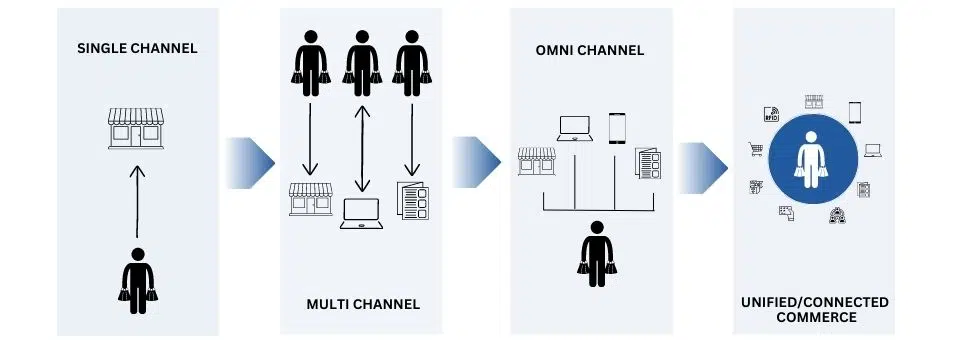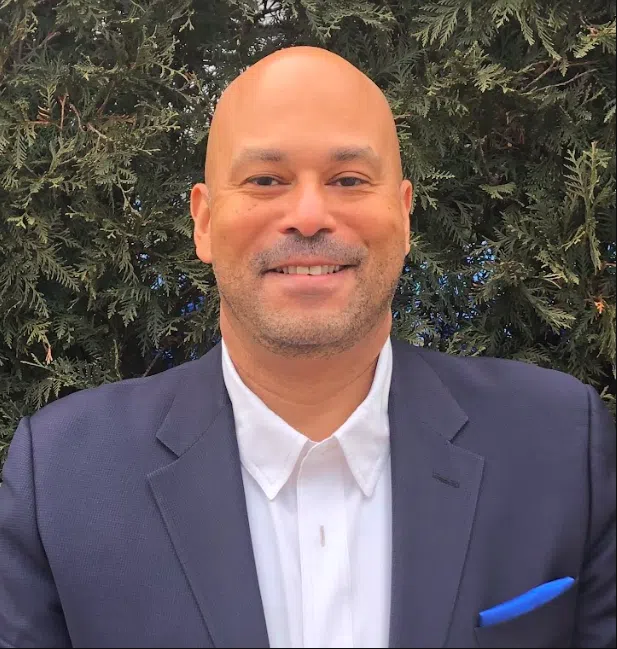Four questions your retail brand should be asking now.
By Terrance Young, Principal, Columbus Consulting International

If you are like nearly 80% of all retailers today, you probably think your unified commerce strategy is not delivering the omni-channel, seamless experience your customers expect (Periscope research).Even with the endless panels, summits, articles and webinars on the topic, the industry is still behind on unifying its unified commerce strategy. An oxymoron? Not really. Believe it or not, most retailers interchange the terms multi-channel, omni-channel and unified commerce, yet they are completely different. In fact, I would challenge that we have now scaled beyond unified commerce and are facing connected commerce as the new standard.
1. So, what is connected commerce (aka, unified commerce 2.0)? It is a customer first, centralized retail platform connecting and uniting all backend commerce solutions and consumer engagement touchpoints that form a single source of transactional truth. The key to connected commerce is the ability to operate your business by being channel agnostic. Not multi-channel, not omni-channel, but completely and seamlessly unified.
2. How is connected commerce different? Traditionally, retailers looked at product first, sales channel second, customer third. Today, consumers have become the centralized point in the business model; meaning that the end user is now dictating the what, where, when and how to make a purchase. This is fundamentally different than designing a sweater, placing it on a table in a store and waiting for the right shopper to come by between 9am-5pm and find their size in a color that they want and make a purchase at the dictated price. It did not matter if the color they wanted was not available in their size or if the item was ultimately out of stock in the location they were currently shopping. The customer’s choices were based on the product, price, place and promotion business model. This separate channel approach was in effect up until the turn of the modern century where channel-focused retail was common practice. Each location (if there were multiple locations) operated individually, separate staff, separate inventory, separate systems.
Enter the internet and ecommerce and, what used to be a combination of direct mail/call centers and brick and mortar, turned retail on its head and required a new multi-channel approach to managing the business from transactions to returns. Retailers responded by leveraging multiple systems to manage a more seamless front end by offering the same products online and in store, sourcing needed inventory by looking up items across distribution and manually coordinating pricing and promotional strategies. This patch and paste method were how early BOPIS, BORIS, ROPIS and BOSFS were launched—just in time for the pandemic.
Enter the new post pandemic customer expected norms and the far greater business complexities of: exploding mobile commerce, 3rd party selling (wholesale/marketplaces), social selling, RFID product technology, diversified factory sourcing, multiple warehouses/fulfillment centers, cross platform customer loyalty programs, payment options (cash/credit/debit/app/ BNPL/Amazon go, etc.), remote offices and call centers, live chat, SMS, artificial intelligence, and even virtual platforms and resale commerce and retail was, once again, turned on its proverbial head.
Retail legacy systems, organizational structures and even skill sets were now antiquated and retailer speed to succeed quickly turned from catching-up to staying relevant in what seemed overnight.
3. What does connected/true unified commerce entail? The new retail model requires a one system, one view, real-time, frictionless, channel agnostic approach to sourcing/producing, shipping/distributing, inventory/allocating, marketing, selling/transacting, returning/processing and overall operating/servicing. It requires an enterprise focus on the customer in every role, function and decision across the organization that considers: 1. How will this impact the customer? and 2. How will this improve the customer experience? And it needs to identify a single source of truth with 100% end-to-end transparency regardless of how and where the brand/product is offered.
Easy.
4. Now what? Or, for the optimists, what’s next? Technology is your friend. And finding the right team with the right experience are your best friends. Building a connected commerce business model takes more than recognizing the linear flaws in disparate, siloed applications. It takes an honest assessment of the people, process and platforms that are in place. The rapid consolidation of retail from traditional wholesale to direct to consumer has put extra pressure on businesses to not only work faster, but smarter, more efficiently and more profitably. Knowing where to start and what to look for is a critical first step in evolving.
This modern-day retail transformation includes 3 critical components:
- Sourcing and implementing an open-end, agile platform/systems solution.
- Identifying and integrating all functional areas from source to shelf/re-shelf.
- Defining and designing a new organizational model that combines roles and functions with the overall customer experience.
Critical to these components is an enhanced focus on inventory—what you have, how much do you have, where do you have it and at what price/promotion are you offering it? This is where RFID comes into play. What used to be a luxury, and a costly luxury at that, is now an affordable solution to locating, tracking and managing real time inventory from manufacturer to consumer. RFID provides greater inventory accuracy for retailers. It allows brands to know the location of their products, helps minimize shrink and empowers the field to have better standards adherence with their merchandising. RFID also solves for more efficient cycle counts which can now be done weekly vs annually.
Other technology enhancements like mobile POS are further driving connected efficiencies for retailers. What used to be an Apple innovation has become common practice in unified commerce business models. Allowing sales associates to engage fully with customers on the selling floor elongates the shopping period and builds higher UPTs and AOVs. Associates can look up product attributes, check inventory levels (see RFID above), share special promotions, view customer rewards and make additional recommendations all resulting in maximizing the sale before shoppers enter the queue line.
Even employee training models are evolving with connected commerce practices. Instead of leveraging team zoom calls, in person or in store/remote group training, associates can now engage with new products and programs directly via tablet/mobile training. The training platforms can now be fully connected to the main systems—providing real time information on deliveries, inventory and merchandise collections. Plus, new remote learning measures platform time and module completion, keeping associates accountable and empowered to serve customers.
If retailers have learned anything over the last few years, it is that the need to keep evolving and staying relevant is critical to competing in today’s market. New, higher levels of customer expectations coupled with more affordable and advanced technologies are propelling retailers to seek a more channel agnostic approach to business. Becoming more accurate, more informed, more visible and more immediate are the main ingredients of unified commerce. Applying a connected approach to people, processes, products and platforms is positioning retailers to not just survive, but to excel. NRF research found that 2/3rds of retailers embracing unified commerce expect a minimum 10% improvement in margin, efficiencies and revenue. Additional ROI measures also include increased customer acquisition and higher levels of retention, loyalty and lifetime value.
Need help? Utilizing consultants like Columbus Consulting can provide immediate expertise and support to help you build a connected commerce model. In selecting a partner, make sure they have practical retail experience and can assist you from assessment and strategy through implementation and training. Unified commerce consultants should be able to define, deliver and guide systems selections. They need to be able to create IT roadmaps, manage data inputs and configure a connected platform. And, they should be able to integrate store systems and mobile devices. Finally, the right consulting partner will be able to work within your organization like members of your team to impact process and change management from the inside and provide cross functional training and facilitation.
Regardless of where you are on your retail transformation, it is always time to evolve. Because if you are not speeding to succeed, you are on a path of speeding to fail. And your customers won’t wait for you to catch-up.
About Terrance Young

Terrance Young is a dynamic retail and technology expert who has an innovative entrepreneurial mindset. He is adept at analyzing retail operations & technologies and identifying opportunities and developing winning solutions. Terrance has 25+ years of extensive Point of Sale, Retail ERP & Project Management experience. In addition, he has strong interpersonal and communication skills, is flexible in meeting evolving needs of projects and has a proven ability to collaborate and successfully meet project goals leveraging his implementation expertise. Terrance is currently a consultant at Columbus Consulting International and is at the forefront of connected commerce in the retail industry. You can connect with Terrance directly at: tyoung@columbusconsulting.com
About Columbus Consulting
Columbus Consulting delivers solutions that drive actual value and have been transforming the retail and CPG industries for over two decades. We are a retail consulting company of retail experts. Our approach is simple – if you do it, we do it. We are more than retail consultants; we are experienced practitioners who sat in our clients’ seats. We understand the challenges, know what questions to ask, and deliver the right solutions. Columbus offers a unique, consumer-centric approach with an end-to-end perspective that bridges functional & organizational silos from strategy to execution. Our specialties include unified commerce consulting, planning & merchandising consulting, sourcing & supply chain consulting, inventory management consulting, finance & operations consulting, data & analytics consulting, information technology consulting, and people & organization consulting. Let us know how we can help you. To learn more, visit COLUMBUSCONSULTING.COM.

